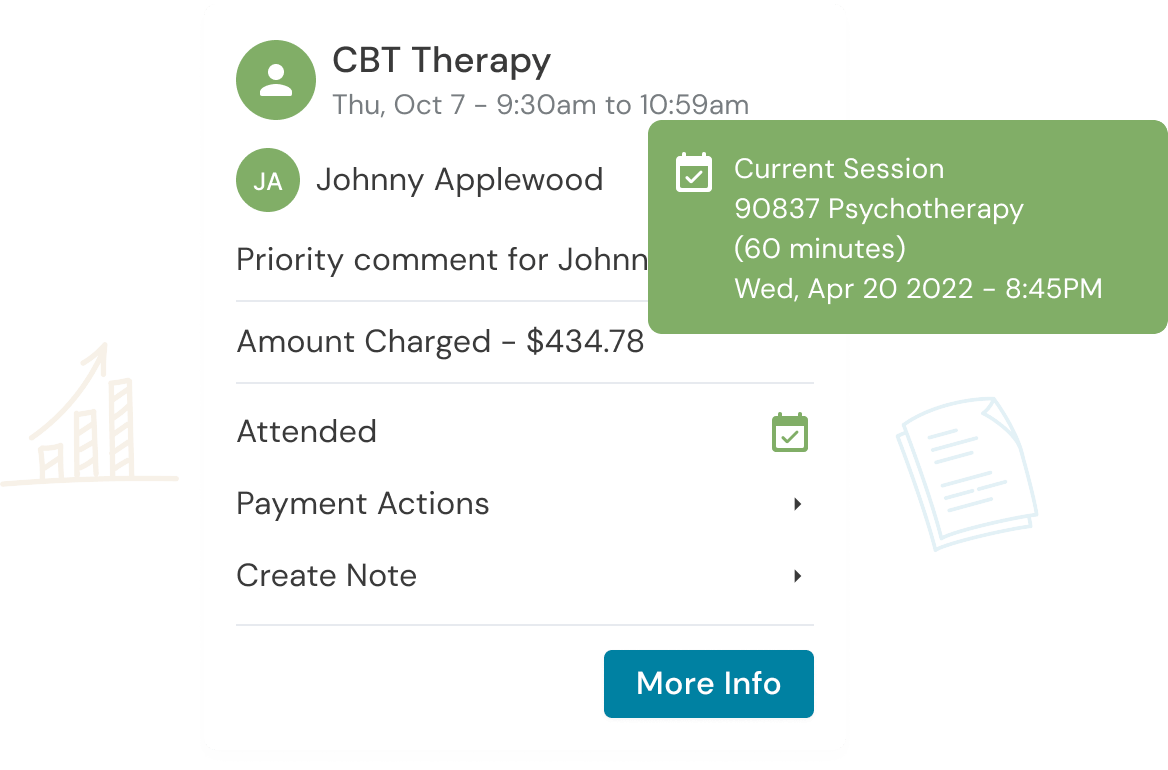Your online presence has the power to help you stand out to prospective clients before they even set foot in your door. Authentic branding can help clients instantly understand what it would be like to work with you as their therapist and motivate them to seek you out for care.
The first step in creating an authentic brand is to identify your niche; the second is to communicate it in a way that drives your ideal clientele to respond. Here’s how you can craft an online presence that represents all the strengths of your practice, as well as common pitfalls to avoid.

How to Identify Your Private Practice Niche: 4 Do’s & 4 Don’ts
DO:
1. Identify the clients you most enjoy working with – and keep them top of mind
Take a moment to reflect: who are the clients whose sessions fill you with an immense sense of satisfaction and pride? Let those clients serve as your muse as you craft your brand.
For easy reference, it may help to sketch out an ideal client profile, so you know exactly to whom you’re speaking. Ask yourself the following questions:
What are their basic demographics?
Consider any factors that may determine how, when, why, and where they seek treatment, including their age, SES, career stage or field, relationship status, cultural and racial background, and gender and sexual identity.
What are their struggles? What are their strengths?
Beyond diagnostic categories, consider what is going through your typical client’s mind when they are contemplating therapy. What headspace are they in? What is working well in their lives, and where do they get stuck?
Why are they seeking therapy now? What has stopped them from seeking treatment in the past?
Consider what is unique about this moment in life for your clients, and what barriers may impede their access to care.
Be as detailed as possible at this stage; think about your ideal client as if they were a character you’re creating. Investigate them from all angles until they’re real to you: you can picture them in your head, hear their voice, and know their struggles as if they were your own. As you develop your branding, you’ll use this client profile to tailor content directly to your core audience.
2. Consider how your own personal and professional background can be an asset
Maybe you’re a former writer who’s witnessed firsthand the existential crises and creative roadblocks that artists face. Or you’ve spent time nourishing your spiritual health, and want to help others do the same. Or perhaps you’ve seen firsthand how yoga and breathwork can reignite the mind-body connection and spur healing.
Take a deep look at the things that bring you joy outside of the therapy room, whatever they may be. You might find you can leverage your experiences in unexpected ways, and use this unique insight to speak your client’s natural language.
3. Network, so you can learn what else is out there!
Hearing what colleagues – and colleagues of colleagues – are up to provides a peek into what’s possible, as well as the opportunity to explore what needs are currently being met in your community, and where there may be gaps in care.
If the word “networking” has a schmoozy connotation to you, remember that the point isn’t to sell yourself; it’s to establish and nurture connections with others – something already well within your wheelhouse.
4. Let your past and future training guide you
A good rule of thumb is that by the time you’re thinking about developing a niche, you already have one. Look back at the electives you chose in graduate school, and the CEs you’ve taken since. What are the common threads? What populations did your clinical placements expose you to, which you are now uniquely qualified to serve?
If your background is in substance use, but you only want to see couples, that’s fine – just make sure you seek out extra training in couples counseling first!
DON’T:
1. Cast too wide of a specialty net
Many therapists instinctively want to help everyone. But the truth is, you’ll have better success at receiving suitable referrals if you identify a few specific populations you enjoy working with.
So rather than listing every population you’ve ever worked with, think about your personal and professional journey. How has is has positioned you to serve a given community?
2. Focus solely on one population if it’s a saturated market
The flip side of overgeneralization is hyper-focusing on a population that is already well-served in your area.
For example, as much as you may love working with perinatal clients – and should absolutely make your practice accessible to them, if that’s one of your passions – remember that a) it can be exceptionally difficult to get new parents into the office, and b) there may already be a high availability of therapists who specialize in this population.
Plus, getting too niche runs the risk of alienating clientele outside your specialty, but with whom you do really enjoy working. Do some legwork up front by speaking to referral coordinators to find out what needs are underserved in your community, and how you might be uniquely positioned to fill them.
3. Pass up an opportunity to gain educational experience
Just because you’ve already met your CEs for the year doesn’t mean you have to stop learning! Keep an eye out for free online courses – since there’s no financial investment involved, it gives you a chance to check out topics outside your niche and see if they inspire you.
4. Claim to be an expert in everything (or an area in which you’re not)
Doing so comes across as inauthentic to clients — not to mention, colleagues can call your bluff, which could affect your clinical reputation, online and in-person.
Instead, if there’s an approach or condition you’d like to specialize in, research how many educational hours your state licensing board considers to be an “expert.” If there is not a specified amount of hours regulated by the licensing board, try cross-referencing with other states or checking with colleagues; getting more than recommended can’t hurt!
Be especially careful of making generalizations when it comes to issues of identity. Though you might be wonderfully multiculturally sensitive, no one has experience working with clients from “all cultures.” Equally, the LGBTQIA community is a huge umbrella that takes special awareness and skill to serve responsibly.

Grow with Owl Practice.
How to Craft Your Professional Statement: 4 Do’s & 3 Don’ts

Now that you’ve identified your ideal client and narrowed down your specialties, it’s time to create a one-of-a-kind professional statement that helps clients understand how, and why, you can help them. Here are tips for effectively doing so:
DO:
1. Focus your language towards the client
Heavy use of jargon overwhelms first-time therapy seekers (and some seasoned ones, too!). Help make potential clients feel at ease by avoiding profession-specific terminology.
If you’re a specialist in EMDR, for example, spell out what that means – both literally (i.e., Eye Movement Desensitization and Reprocessing), and in terms of what clients can expect to happen in sessions, and what they’ll get out of it.
2. Give concrete examples on the ways you can help potential clients
Do you dabble in existential therapy to help clients contend with life’s greater questions? Or maybe you go on walks with postpartum clients to deepen mother-infant bonding.
Whatever is unique or compelling about your approach, let clients know! Give clients concrete examples to help them visualize what sessions with you are like and get excited about how the tools or lessons they’ll take away.
Focus on the positives, what they’ll gain from working with you, and end on a hopeful note of how their lives will be improved afterward.
3. Sprinkle keywords into your site to improve your chances of ranking online
Clients often search by keywords – ranging from targeted queries like “therapist for divorce” to as open-ended as “help with panic attacks” – so using key terms on your site helps search engines understand you’re the ideal result for what clients are seeking.
Consider penning a blog post on a niche topic you specialize in, such as “How CBT Helps Teens with Social Anxiety” that boosts your credibility for search engines (as well as the parents who are doing the searching).
4. Ask a non-therapist friend for their opinion on your statement
If you’re having trouble striking a balance between stating specifics without being exclusionary, ask a non-therapist friend to read back the content you put together. Have them share their impressions of what you specialize in, and who your practice is open to. If they’re way off-base, you may need to go back to the drawing board.
DON’T:
1. Forget to spell check
Nothing will turn off the professional audience you’re hoping to reach faster than a bunch of typos. Increase client confidence with a well-written, grammatically correct profile.
Get rid of the all caps, ellipses, and excessive punctuation before you hit “save.” When you only have a short amount of space every detail matters, so run your profile past a friend or wait a day before hitting “publish” for a fresh pair of eyes.
2. Write in clichés
Opening statements like “Are you feeling stuck?” are rote in nature, and won’t do anything to show clients why they should work with you versus any other therapist.
Instead, get inside your client’s headspace to show you understand them! Saying “I specialize in eating disorders” is one thing; it’s another altogether to write “Living with a complicated relationship to food can feel isolating, but you don’t have to go through it alone. I will work with you to understand where harmful behaviors are coming from, as well as what steps are necessary to start your journey to healing.”
Take a moment to go back through your ideal client profile. Point by point, what is it that your client needs to hear in this moment? Remember that therapy is a service – how are you going to make your practice work for them?
3. Use dated, grainy, or inappropriate photos in your profile
You can write the world’s most eloquent professional statement, but humans are visually-driven creatures – and we tend to rush to judgment quickly. All the hard work you’ve put into cultivating an online presence will be moot if you don’t use a professional pic.
Make sure a warm, up-to-date photo of you (and your office!) is the first thing clients see when they visit your profile or website.
Putting the initial work into determining your niche and positioning yourself as an expert takes time and consideration, but when done well, it can pay off immensely!
As you continue connecting with clients who energize you, you’ll be able to stave off burnout – and reserve the emotional bandwidth that’s crucial for you to continue learning and growing in the profession.



